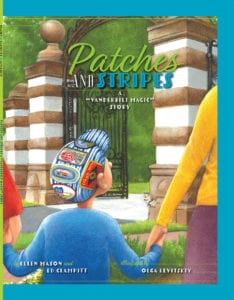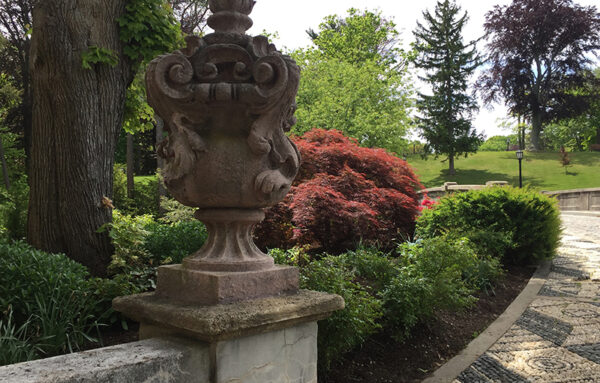Book Launch:
Weekend of October 17-18
A family with a young son visited the Suffolk County Vanderbilt Museum a few winters ago and lost a family heirloom. The story of what happened next is the subject of a new book by two Vanderbilt colleagues.
Authors Ed Clampitt and Ellen Mason have co-written and self-published a children’s book, Patches and Stripes, which they call a story of “Vanderbilt magic.” It is written in the form of a 44-stanza poem.
****
The Museum will host a book launch on Saturday and Sunday, October 17-18, outside the Vanderbilt Carriage House –11:00 to 3:00 pm. Members only from 11:00 to 12:00. Meet the authors and illustrator. Books: $10. After this book signing event, Patches and Stripes will be available exclusively in the Gift Shop. All proceeds will benefit the Museum.
****
The heirloom was a hat – a small, striped railroad cap, passed down to the family’s young son. (Above: cover and illustrations by artist Olga Levitskiy.) The cap was decorated with patches sewn-on by generations of railroad conductors, including the boy’s father, grandfather, and a few brothers. The boy was next in line to own it.
Clampitt, a Huntington resident and member of the Vanderbilt staff, also has been a longtime employee of Stop & Shop supermarkets. He is co-creator and author of Team Dawg, a character-education program and children’s book series that has been used widely in elementary schools throughout Long Island.
Mason, a Stony Brook resident and retired Centereach High School English teacher, leads tours of the Vanderbilt Mansion and is a costumed actor-guide in the Museum’s Living History tours.
“Ed enthusiastically related the details and said he was thinking of describing the incident in a short story,” Mason said. “I suggested the event might also be inspiration for a children’s book. A few days later, I showed him the beginning of a poem that would eventually develop into the one in this book. Ed invited me to collaborate.”
The story began in the winter of 2017. Ed Clampitt dashed from his full-time job, quickly changed clothes, and drove to the Vanderbilt to begin his shift. Running a bit late, he found he did not have time to stop and pick up the day’s traditional snack, a box of Dunkin Donuts, for his security colleagues.
He started his day by welcoming the family that owned the cap. The boy’s mother told Clampitt her story. She was distraught about losing the cap and had come back to look for it. She added, “You have no idea what this hat means to us. It can’t be lost. It can’t.”
Clampitt gave them a tram ride downhill to the Vanderbilt Mansion, and they searched everywhere, talking with the mansion-tour guides, and hiking acres of the estate’s rolling lawn. They checked with the Planetarium admission desk, where lost things wait to be claimed. No one had turned in the lost cap.
“They left their contact information with the Planetarium staff in case the hat turned up,” Clampitt said. “I’m sure that was a final act of desperation, figuring all hope had been exhausted.” He returned to the security booth, where his friends ribbed him about forgetting the donuts. He felt bad about letting them down.
One colleague asked Clampitt and the others, “Did you guys see the email from [supervisor] Keith about the lost hat?” The question got Clampitt’s immediate attention.
“Wait! What? A hat? What about a hat?” Clampitt asked. “You have no idea. They were here today looking for that hat. It was a family heirloom. The mother was heartbroken.”
Clampitt explained. Steven, one of his colleagues, smiled and pointed toward the wall. “There it was,” Clampitt said, “hanging quietly on the utility hook, out of place with a few hangers, a reflective safety vest and a slightly broken umbrella. That precious hat, right there, hidden in plain sight.”
“Oh, my God!” Clampitt shouted. “You guys have no idea! That family was here all day searching for that hat. We have to get a hold of them.” They called the Planetarium for the family’s contact information.
Steven called the mother to ask if she had recently lost a child’s hat. He said it had been found. For the next few moments, the only words he could manage were, “You’re welcome, it’s OK, you’re welcome…” The mother kept saying, “thank you, I love you, I could kiss you, over and over.” Steven told her they would be in the guard booth until 11:00 that night.
She returned that evening, thanked everyone again, and handed two boxes to Clampitt. “A little something to show our thanks,” she said, “the least I could do.” In the boxes: Dunkin Donuts.
“Call it redemption. Call it karma, or maybe a bit of both,” Clampitt said. “I shared the story with friends and family. From their reactions, I felt compelled to write it down.
“I’m not sure if my written words could ever do justice to the reality of what happened. But I am sure there is a greater power at play here. It’s magic, the kind that draws visitors here, makes time stand still, and brings peace to those who come.
“Maybe it’s the spirit of one lifetime railroad family [the Vanderbilts created the New York Central Railroad] helping out another railroad family. Or you can explain it all away as just a bizarre coincidence.
“They say never let the facts get in the way of a good story. I say sometimes the facts can make a great story, a magic story – a Vanderbilt magic story.”
Authors’ back story:
Ellen Mason said when they decided to write the children’s version of the story, they each wanted certain things. “Ed wanted to emphasize the donuts and the Vanderbilt magic, and to make a connection between the railroading family that lost the hat, and the Vanderbilts,” who at one time controlled most of the railroads east of the Mississippi River.
“I wanted to condense the story into one day and provide a tour of some of the museum exhibits during their search for the hat,” Mason said. “I insisted that Ed find the hat in this version. I wanted him as a main character and for him to be the hero in this story. The children’s book reflects all of these. In my author’s note, I state that there are obvious differences between these two versions.
Clampitt said to translate the original story into the 44-stanza poem that became Patches and Stripes took creative license. “Hence, my efforts to write the actual story,” he said. “Although in the book I find the hat, it was a team effort.
“To date we don’t know how the hat actually turned up in the booth,” he said. “Legend has it that it may have been found by a grounds crew member or turned in by another guest.”





